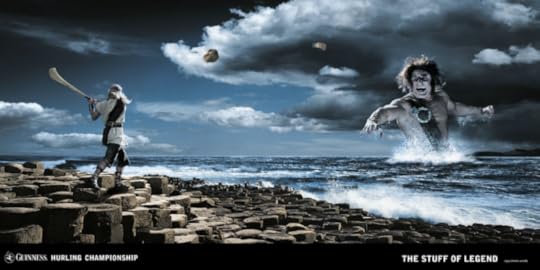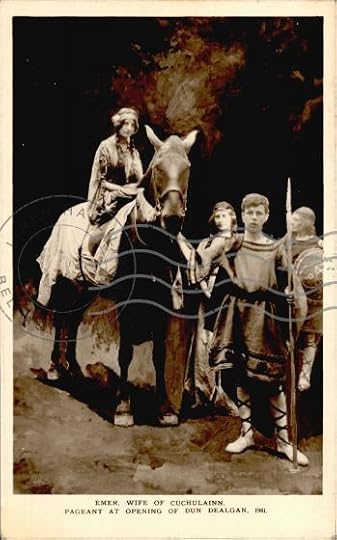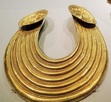Brian O'Sullivan's Blog, page 5
October 9, 2024
Dead Men Standing
One thread that occasionally raises its head throughout Irish mythology is the motif associated with the burial process of some rí (a word often mistranslated as ‘king’ but more accurately translated as ‘chieftain’) or mythological celebrities, where the corpse is bound upright or interred in the standing position, usually in defiance of an enemy or rival population group.
The early and medieval Irish literature contains several references in this regard but the most famous is probably linked to that of Cú Chulainn who, in a final act of defiance, ties himself to a standing stone to die on his feet. Facing his enemies, he remains upright for three days after he dies as they’re too terrified to come close (clearly, nobody thought of throwing a stone!).
Another celebrity associated with upright burials was Laoghaire (son of the infamous Niall). Famous for his hostile interactions with Saint Pat, Laoighaire is recorded (by Tíreachán) as being buried on the ridges of Tara, placed upright and facing south in defiance of the Leinster tribes. This follows somewhat in his father’s footsteps, given that Neill’s body was also said to have been held aloft by his tuath as a good-luck token when heading off to battle.
Early Irish literature has a few other references to the bodies of chieftains and heroes being buried upright and although there is a possibility that might have reflected some kind of burial ritual linked to the cult of warriors, it’s very much a literary motif rather than a historical one. As a result, you really have to be careful with its interpretation.
October 6, 2024
Forthcoming Production
This is a brief update on books that are planned /anticipated for release over the next 3-12 months. There’s further detail available in the September newsletter (Vóg) but I’m sure there’s something in the list below for everyone.
Confirmed Releases:
FIONN: The Betrayal (book six in the Fionn mac Cumhaill Series)
Although it’s still unclear whether this will the final book in the series or not, this follow up to ‘FIONN: The Tightening Trail’ will be available in March/April 2025 (and, hopefully, available free to newsletter supporters for Christmas). There will be A LOT of plot resolutions and revelations in this book.
Potential Releases:
At least one of the following will be released in 2025.
(1) Liath Luachra: The Hungry People (LL5)
The follow up to ‘Liath Luachra: The Metal Men’, this covers Liath Luachra’s deepening relationship with Bodhmhall and her conflict with new and existing enemies.
(2) Liath Luachra: The Quiet One
Another stand-alone novel, this follows on from ‘Liath Luachra: The Great Wild‘ and details another chilling adventure of the young warrior woman before she joins Bressal and Na Cinéaltaí.
(3) ‘Irish Mythology’ 101
‘Irish Mythology’ 101 essentially outlines the fundamentals of how ‘mythology’ works and how you can make sense of it /use it in contemporary life. It’s very much based on the cultural parameters within which I work and operate on a personal basis.
(4) Beara Series
A new adventure from Ireland’s greatest mythological detective (Muiris O’Súilleabháin ) as he deals with the double threat of a murderer and a dangerous banshee.
(5) The Irish Battle Trilogy
A trilogy of books on a famous Irish battle and the somewhat insane characters who took part in it. This is currently the lowest on my list of priorities.
September 26, 2024
Who was Fiacail mac Codhna
Fiacail mac Codhna is a swaggering and irrepressible warrior from the Fionn mac Cumhaill Series, based on the original Fenian narratives. Handsome, charming, and shrewdly strategic in battle, Fiacail’s potential for tribal greatness is undermined only by an over-sexed libido and a strong weakness for women, particularly where it relates to Bodhmhall ua Baoiscne, sometimes – but not always – portrayed as the aunt of Fionn mac Cumhaill.
Previously bonded to Bodhmhall, Fiacail’s tomcat behaviour eventually led to the dissolution of their relationship, something he still regrets many years later.
Fiacail mac Codhna’s quite a lot of fun as a character. He can be charmingly crass at times – particularly where it relates to sex – but his humour and genuine attraction to Bodhmhall means he’s a credible third player in the love triangle with Bodhmhall and Liath Luachra. His bawdy humour and blunt demeanour, meanwhile, offers welcome relief from some of the more serious and intellectual characters in the series.
When not chasing women, Fiacail likes long walks in the mornings (usually naked), having conversations with Great Father Sun. Much of this involves trying to convince Father Sun not to cause the end of the world but there’s also the occasional attempt to negotiate the gift of a pony.
Fiacail turns up on several occasions over the course of the original Fenian narratives, usually as a kind of foster father/advisor to the young Fionn mac Cumhaill. In some of the manuscripts however, he’s referred to as a ‘reaver’.
In modern Irish, ‘fiacail’ is actually the word for ‘tooth’ so it seems an unusual name for a character. Sadly, the name is so old even the Fenian narratives in the original manuscripts offer little explanation for its origin. As a result, I had to come up with own rationale
September 22, 2024
Liath Luachra
A recent commission of ‘Liath Luachra’ for another project I’m working on (more on that in the next newsletter). I suspect I won’t be using this particular image. It feels more like a ‘Celtic Fantasy’ version of the character which, from my perspective, doesn’t work.
We’ll see.
September 17, 2024
Goll mac Morna
Military leader of Clann Morna (not the chieftain), Goll mac Morna takes on a much larger role in Fionn mac Cumhaill’s life as the core Fenian narrative progresses.
Interestingly, you rarely see much about Goll from the English web content publishers (generally, because they don’t really understand how Gaelic culture works in the Fenian narratives) but Goll is actually quite the fascinating character when you get to know him.
All the same, you still wouldn’t want to meet him alone on a dark night.
September 9, 2024
In Cú Chulainn’s Footsteps
Ireland’s ‘Poc Fada’ (Long Puck) competition was originally inspired by the old Ulster tale of Cú Chulainn travelling across the Cooley Mountains to the territory land of his uncle, Conchubar mac Neasa. Bored by the journey, the young Cú Chulainn (then, Setanta) decided to shorten the road by ‘pucking’ a ball ahead of himself and then running to catch it before it hit the ground.
The more modern version of that is an unusual competition where the participants not only compete with each other across the Cooley Mountain, but compete with nature and the elements as well, all the while traversing a landscape emanating a genuine sense of ancient history and culture.
The first Poc Fada competition was held in 1960 with competitors following a designated trail over the ridge of the Cooley Mountains, pucking the sliotar over a distance of slightly more than three miles. That competition consisted of six young hurlers from the Dundalk region but by 1962, the popularity of the competition meant hurlers from all parts of the country were participating.
In its early days, the course was marked out with temporary flags but as the competition became more established, these were replaced by permanent standing stones. The rules of the competition are quite similar to golf in that the person who can hit the sliotar (the ball) through the outlined trail with as few pucks as possible is the winner.
In the early 1980s, the competition was revised with a new course through the Cooley Mountains (now, approximately 5km in length) and in 2004, camogie players were finally allowed to take part. To date, the record for the Cooley Mountains course stands at an impressive 48 pucks . That basically means the winner slammed the sliotar over an average distance of about 104 metres per puck – quite a remarkable feat – I certainly couldn’t do it.
The competition is still ongoing with the latest taking place last month on August 5th.
September 5, 2024
An Irish ‘Mythology’ Test
Irish (and other) cultural stories frequently get used in advertising campaigns – particularly where the base story can be linked to an ‘Irish’-related product. A lot of the time however, those advertisements can be misrepresentative or simply get things wrong.
Take this Guinness campaign for the Guinness-sponsored All-Ireland Hurling Championship, for example. If you look closely, you’ll see that one of the three Cú Chulainn images in the advertising campaign got its sources mixed up. Can you tell which one it was?
Photo A (The Bull)

(b) Photo B (The Giant)

Photo C (The Hound)

If you can’t work it out, you’ll find the answer in the original post HERE.
September 2, 2024
Deirdre Unforgiven
I came across an interesting book – Deirdre Unforgiven – by Eamon Carr during my recent visit home. Sitting in a friend’s bookshelf, I found myself drawn to it by the bleak cover image from Irish artist John Devlin.
A brief flip through it revealed the book was a clever conflation of the ancient Irish tragedy with more contemporary ‘troubles’ in the north of Ireland covered by Eamon Carr during his time as a journalist. As a result, it’s quite powerful and evocative but it’s certainly not light reading.
Certainly interesting for those with a link to/or interest in Northern Ireland and a familiarity with the raw narrative of the original tale, it can be ordered through the usual outlets.
Ar ais sa Oifig/ Back in the Office
We’re back in the office. A bit jetlagged, overwhelmed, and still processing what we’ve seen, but normal service should resume later this week.
August 3, 2024
Cosplaying Irish History
The site of Cú Chulainn’s supposed settlement at Dún Dealgan (which actually means ‘the Dún of Dalga’) was, in far more recent times, anglicized to Dundalk. When the town opened its first museum in 1901, therefore, it’s no surprise that they harkened back to the town’s imagined history rather than its real history – which involved colonisation, land grabbing, subjugation, and was a lot less appealing – to celebrate its opening.
That opening was marked with a huge outdoor pageant with numerous people dressed up in authentic fantasy costumes of the period. To celebrate the occasion four postcards were also produced.

Outdoor pageants of this type were very popular at the time but, obviously, come 1916, people had a lot more on their mind and they fell out of fashion.
Interestingly enough, go to any ‘mythology’-related event in Ireland and it seems to have become more popular again.



